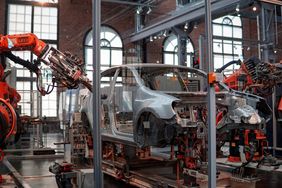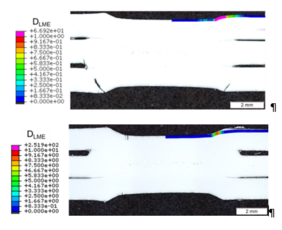Galvanized and thus corrosion protected high-strength steels with increased ductility provide an excellent combination for the automotive industry combining good ductility and excellent corrosion resistance with weight saving potential.
Liquid metal embrittlement (LME), is a phenomenon of practical importance in which certain ductile metals suffer a drastic loss of ductility or brittle fracture when exposed to certain liquid metals (e.g. during welding of automotive components, see image 1).
At MCL, various options have been developed to reduce LME. To improve the process, different welding parameters and electrode cap geometries were investigated numerically and experimentally.
With a specially developed and validated multi-physical simulation model, the unknown states during welding can be understood in detail. Together with the company partners Plansee, Mercedes Benz and voestalpine, MCL was able to optimize the standard electrode cap shape using this model aiming at LME reduction. This resulted in the new, so-called K-electrode cap (k stands for klothoid-shaped).
With this new geometry, it was possible to reduce LME while maintaining good weldability.
In Image 2, the advantage of the K-electrode is shown on the basis of a 3-sheet welded joint. In the upper picture, LME-induced cracks can be seen at both sides of the welding spot. The weld spot made with K-electrode shown below does not reveal any cracks. In the simulation, the colored zones in Fig. 2 show the specially developed model-based damage indicator (DLME), which is significantly lower with the new geometry.
Laboratory tests show a tendency that the K-electrode caps have a comparable electrode durability.
Impact and effects
The novel K-electrode cap geometry was filed as a utility model.
Further welding tests as part of a project extension to join different sheet materials have yielded promising results. A next step will be to apply the effect of the K-electrode cap to spot welds in test car bodies to verify the suitability of the K-electrode caps in service.
Project coordination (Story)
Dr. Konstantin Prabitz
Department Simulation
Materials Center Leoben Forschung GmbH
T +43 (0) 3842 45922-0
konstantin.prabitz(at)mcl.at
IC-MPPE / COMET-Zentrum
Materials Center Leoben Forschung GmbH
Roseggerstrasse 12
8700 Leoben
T +43 (0) 3842 45922-0
mclburo@mcl.at
www.mcl.at
Project partners
• voestalpine Stahl GmbH, Austria
• Plansee SE, Austria
• Mercedes Benz AG, Germany
• Montanuniversität Leoben, Austria




















